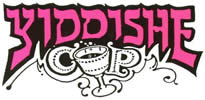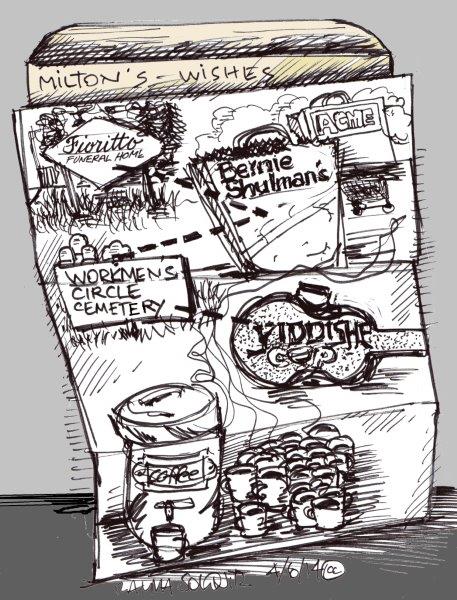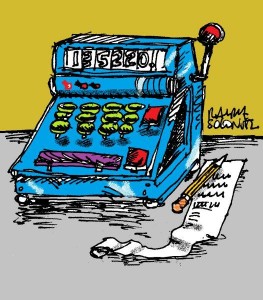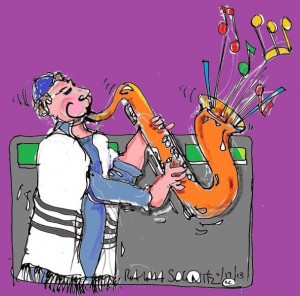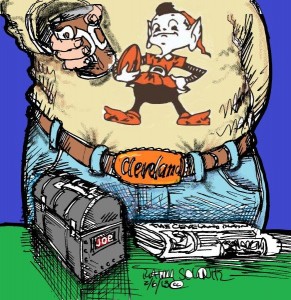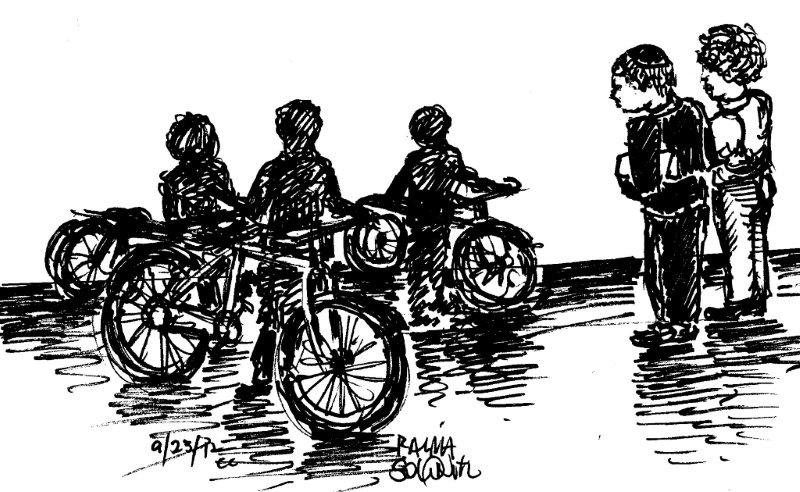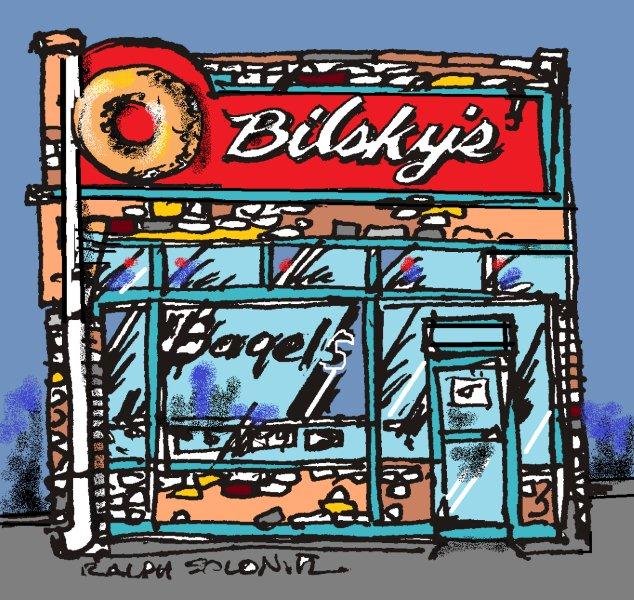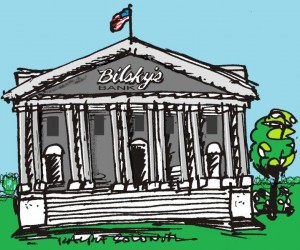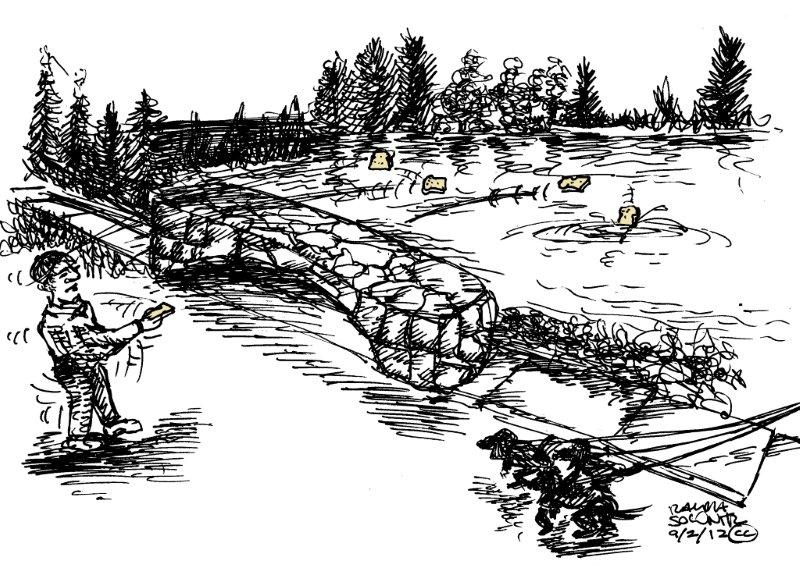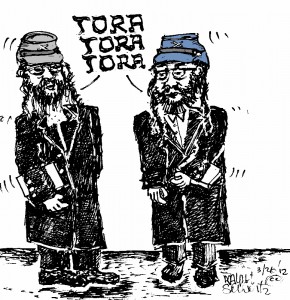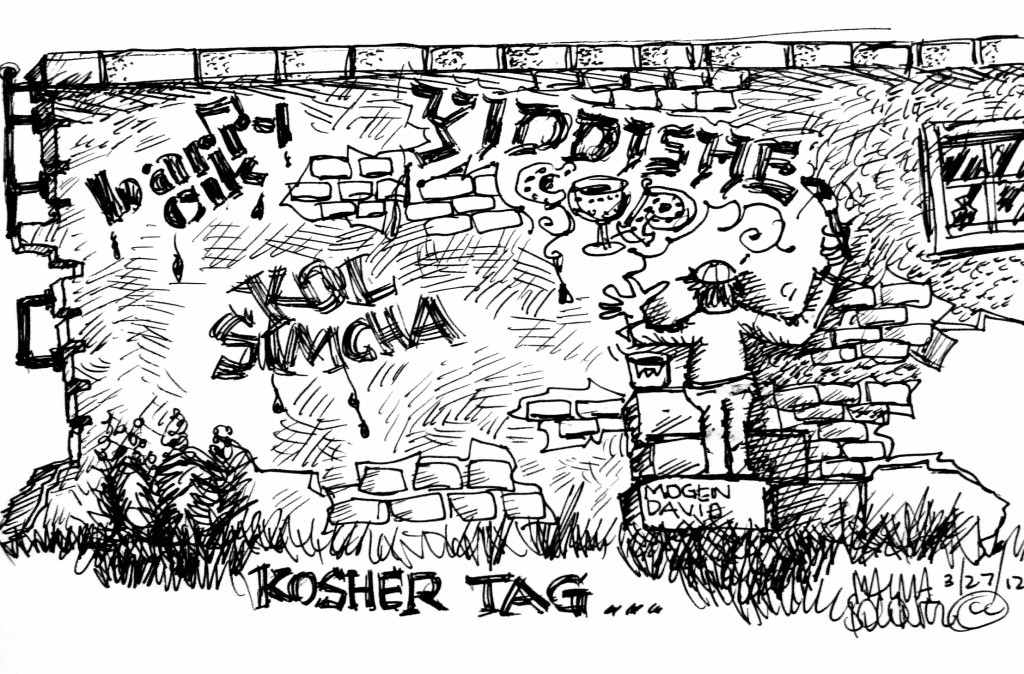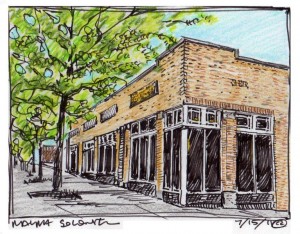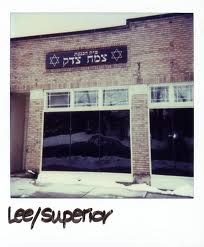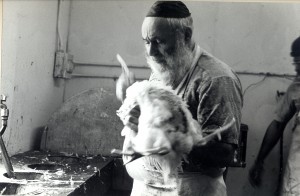Category — Shul Talk
WHO BY FIRE
Rabbi Abba Hillel Silver, pictured below, was the biggest Zionist to come out of Cleveland. If you know anything about American Jewish history, you know this guy. He and Rabbi Stephen Wise were the big Jews in the pre-WWII American rabbinate. Silver was the rabbi at The Temple –Tifereth Israel, a k a Silver’s Temple. He lobbied for the state of Israel back when many American Jews were not too sure that was a good idea.
My family belonged to Silver’s Temple. The temple’s official name was The Temple.
“Which temple do you belong to?”
“The.”
“The what?”
“The Temple. It’s The Temple.”
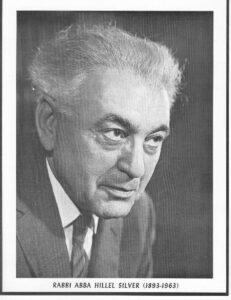
“The Temple” morphed into The Temple-Tifereth Israel after the rabbi and his son (also a rabbi) died. My family didn’t really fit in there in the 1960s, because many of the members were a lot richer, many from Shaker Heights. One Shaker kid arrived in a station wagon driven by a chauffeur with a shiny-visor cap.
Rabbi Silver was a chochem (wise man). He knew his stuff. And he hung with the guys from Telshe Yeshiva, too. The black-hat Orthos. He covered all the bases. What do I know? I was 13 when Rabbi Silver died.
My younger son went through religious high school at The Temple. The place had mellowed by then. It wasn’t as snobbish. Nobody cared anymore if you were Deutsche Yehudim — one of Cleveland’s original German Jewish settlers. When my parents left Silver’s, they went to Temple Emanu El, a middle-class temple in the ‘burbs. My mom taught macramé there and volunteered in the sisterhood gift shop. She collected “donor points” for volunteering — points that reduced her admission costs to the annual temple dance.
Yiddishe Cup has played some of these temple dances. Not so many lately because few people want to dance at temples. They’d rather stay home and watch people dance on TV. We played a “dance,” sort of, last Saturday night. Simchat Torah. That was very low key because of the war. The rabbi and I decided the band would play a few Israeli tunes and dances. Nothing too wild.
My parents joined the heymish synagogue, Emanu El, after I was confirmed. (Heymish — the word — should be banned, by the way. Too heymish.)
On the High Holidays, I went with my parents to Emanu El, or else with my friends to Hillel at Case Western Reserve. After Rosh Hashanah services, we’d eat at Tommy’s restaurant. I tried that again this year – the Tommy’s part. You couldn’t get into Tommy’s this year after Rosh; it was jammed with yidn.
Years ago an older woman told me, “I joined Fairmount Temple because I like the music there.” She had other reasons too: Brith Emeth didn’t have enough money to spend on carpet, she said, and she liked Fairmount Temple’s classic Reform music. That stuck with me: joining a temple for the music.
Nowadays Fairmount is contemporary guitar-centric Jewish music, and I like the cantor, Vlad Lapin. My band played there last Friday night. That was lively. That was pre-war. (And don’t worry, we’re going to kick out the jams the next time we play.)
I belong to Park Synagogue because, among other things, I like the music and the rabbi, who likes my band, which is scheduled to play Park Synagogue’s holiday celebrations until 5800. I once played a holiday gig at another shul, where the rabbi left early to attend a rock concert. He said he was seeing a famous band downtown. I wasn’t impressed. Hey, the rabbi was walking out on Yiddishe Cup! It’s impossible to be a rabbi.
Park Synagogue uses a choir once in a while. Some Jews think a choir is super-goyish. Not true. In Europe there were synagogue choirs as far back as the 1500s.
Some temples have rock bands. (I have subbed in several rockin’ shabbat bands.) Some congregants really enjoy that groove. My son the drummer got his start playing in a rockin’ shabbat band at The Temple. Rock on.
By the way, read Matti Friedman’s book about Leonard Cohen playing for the troops in the Sinai in 1973. Who By Fire.
I can see picking a shul for the music. Why not. I enjoy hearing my cantor, Misha Pisman, and I like the cantors my shul imports for the Rosh Hashanah overflow. Either way I’m OK — main sanctuary (with the regular cantor) or overflow with the sub.
I feel like playing music right now for the troops and the people of Israel. Am Yisrael Chai, for starters.
October 10, 2023 2 Comments
THE HEYMISH AND THE AMISH
I live near two large Amish settlements — Middlefield, Ohio, and Holmes County, Ohio. I know some of the differences between the various Amish, like some use battery-powered lights on their buggies and some don’t. Some use the triangular orange “slow vehicle” sign.
Speaking of men-in-black, I also know some Orthodox Jews. I know the crocheted yarmulke means Modern Orthodox and the black hat is more old school. I’ve been around Amish and Jews — at the same time — only once. I walked into Green Road Synagogue (an Orthodox shul) in Cleveland, and there was an Amish man in the lobby. Maybe not. Maybe he was a Modern Orthodox hipster trying to look Amish. He had a wide-brim straw hat, beard, no mustache a la Solzhenitsyn.
Then I saw about 15 Amish women, carrying parfaits on trays, wearing blue dresses and white bonnets, coming out of the kitchen. Next I saw a horse and buggy at the side door of the synagogue. Orthodox Jews started arriving. Most were Modern Orthodox (like dentists and lawyers in knit yarmulkes), but a couple old-school rabbis looked Amish.
“Solzhenitsyn” stacked bales of hay in the temple lobby and brought in chickens. He was John, an Amish from Middlefield. He said he used to be a wheelwright and now worked for an Orthodox Jew in a mattress factory. The mattress-factory owner was hosting this sheva brochas (post-wedding dinner). My band, Yiddishe Cup, was playing. The Orthodox host — the mattress man – was a musician, himself, who had some show-biz flair. He was doing a Blazing Saddles party theme. I asked the Amish buggy driver what he thought of our music. He said, “It sounds like Mozart.” Maybe because of the violin?
“Solzhenitsyn” said some Amish in Ohio play harmonica. “That’s all, for instruments,” he said. “Other instruments [like flute, guitar] might lead to forming a band.” A Jewish joke?
The rabbi, as a joke, asked if we knew any Amish songs. We played “Amazing Grace.” That’s borderline Amish. It was probably a first for Green Road Synagogue. The Amish liked the song, and the Jews ignored us. Then we tried a Yiddish vocal, “Di Grine Kusine,” which didn’t go over. I thought the Amish would like it because Pennsylvania Dutch is Germanic, just like Yiddish. The Amish didn’t react to the song. Now I know: no “Di Grine Kusine” at Amish-Jewish affairs.
—
I had a funny article in the Wall Street Journal last week about old guys playing tennis. Here’s the link. No paywall. And check out the comments, particularly if you’re an old guy.
July 14, 2021 5 Comments
CHOLENT SLIDERS
Cholent was the vehicle for my return to cooking. In the 1970s I took a Chinese cooking class at the Pearl of the Orient. But no cooking classes since. My rabbi’s son hosted a Zoom class on cholent last month.
There were about 50 people at the Zoom meeting. (It’s a big synagogue.) I tried to hide; I muted; I didn’t scream, “I’m a novice!” I dumped beans, barley, kishke, flankn, potatoes and onions into my slow cooker. The instructor, Jared, said the Crock Pot was invented by an Orthodox Jew to slow-cook cholent on shabbat. (Lookin’ that up . . . Yep, the Crock Pot was invented by one Irving Nachumsohn for cholent cooking.)
Most Jews — and everybody else — don’t know what cholent is. It’s mostly an Ortho thing. Cholent is a stew you slowly cook for 12 hours or more, so as not to light a fire on shabbat.
My cholent cooked too long. My stuff came out like a big cow pie. No definition to it. The meat melded into the beans. Just one massive turd.
I had people coming over for dinner and was going to serve it! My wife, Alice, who’s a good cook, turned the cow pies into sliders. She served cholent sliders, without buns, as an appetizer. I didn’t apologize, or say to my guests: “This is my first time!” (Cooks should never apologize. Neither should musicians.)
My friends liked it. Alice added extra pepper and salt, and some soy sauce. And luckily I had picked out the plastic kishke casing prior. I didn’t realize the kishke was wrapped in plastic when I sliced it and dumped it in the stew. The next day I ate huevos cholent — a fried egg on top of a cholent slider. That was good, too. Alice came up with that.
Need cholent?
December 23, 2020 4 Comments
WEDNESDAY THE RABBI
WENT TO LITTLE ROCK
My aunt Bernice said, “The young rabbi thinks the Young People’s Congregation gives out the lifetime tenures.” My uncle Al said, “That rabbi isn’t too smart.” My relatives liked to talk about rabbis — who got fired and why, who moved, who did what to whom, and in what room. AKs talk about rabbis.
Now I’m an AK and I talk about rabbis, even cantors — who’s too political, who’s stuffy, who’s friendly (which basically means they like my band).
Rabbis are celebrities around here. It’s what we do on the East Side of Cleveland — rabbis and Geraldo Rivera. One major-congregation rabbi “pulls down six figures,” my cousin said. I hope so. More like 300K, cuz. Just a guess.
Rabbis need to get out of town occasionally. If they stay in town, they’ll be badgered. If a rabbi goes to, say, Little Rock, Arkansas, the rabbi can do his or her thing. Not saying what that is. But what I am saying is I started this Rabbi Shack, a retreat in Little Rock. There are a few openings.
August 19, 2020 1 Comment
A FUNERAL WITH ALL
THE TRIMMINGS
May 15, 1990
Dear Children,
In 15 days I’ll be 71. As you know, I’m not religious, but I do like a good party. About my funeral: Use the gentile funeral home, Fioritto in Lyndhurst, to deliver my body to the Workmen’s Circle Cemetery. Just bury me. Invite some family and friends. No rabbi! I’ve never gone to synagogue, so don’t start with that now.
Pick a convenient Sunday afternoon to throw a memorial service at the Workmen’s Circle hall on Green Road. There is plenty room, a loudspeaker and a kitchen. Anybody who wants to speak, can speak — except Bernstein.
I want a nice sendoff: trays, Scotch, music, dancing, food, coffee, pastry, wine and cold beer. Whiskey too. Hire a klezmer band — Bert Stratton’s band. But remember, one hour of klezmer is enough.
Get the trays at Bernie Shulman’s at Cedar Center. They’re good and cheap, but you have to pick up the goods yourself. Get pastries from Acme supermarket at Mayfield near Green. Their pastries are excellent and much cheaper than the Jewish bakeries.
I want coffee — lots of coffee. The Workmen’s Circle can make it by the gallon. And plenty of soft drinks and wine — good wine. No Champagne. Hire kitchen help.
Mom will say I’m nuts. She can stay home if she wants! This is what I want.
Love,
Dad
—
Footnote: The author — a friend of my parents — died in 2006, 16 years after he wrote this letter. He lived to 87. He had a graveside service with no band and no food. No hard feelings.
I slightly “enhanced” his letter. I added except Bernstein to “Anybody can speak — except Bernstein,” and I added “One hour of klezmer is enough.” Couldn’t help myself. The letter is real.
October 17, 2018 3 Comments
SHUL SHLUB
During the Torah processional at synagogue, Cohen said to me, “That zipper on your shirt makes a nice tie. Metallic!” He shook his head. Cohen — a snappy dresser — wears a Brooks Brother suit, legit tie and vest. At home, Cohen collects clothes catalogs, like his men’s overcoat catalog from pre-World War II. Cohen once tried to sell me a bomber jacket. I said no. I can’t stand old Jews in bomber jackets.
He eventually sold the bomber jacket on eBay. “Same price you would have paid, Bert.”
“But you paid shipping.”
“No, that was an extra $12.50 to the buyer.”
Cohen kept looking at my zipper. I said, “I spray it with WD-40 to keep it shiny.” It had no name, not even YKK.
I just want to be comfortable at shul. I usually walk to shul — a major hike. I’m not trying to make a countercultural statement. The zipper shirt is the least of it. The rabbi often wears tennis shoes (for health reasons, I’m told). I’m not a complete shlub.
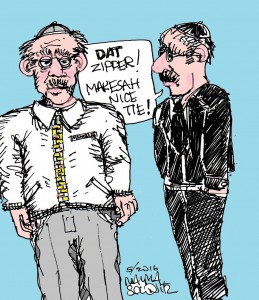
Cohen is a pseudonym
May 18, 2016 2 Comments
A FUNERAL WITH ALL
THE TRIMMINGS
The letter is from Milt — a friend of my parents — to his kids.
May 15, 1990
Dear Children,
In 15 days I’ll be 71.
As you know, I’m not religious, but I do like a good party.
About my funeral: Use the gentile funeral home, Fioritto in Lyndhurst, to deliver my body to the Workmen’s Circle Cemetery. Just bury me. Invite some family and friends. No rabbi! I’ve never gone to synagogue, so don’t start with that now.
Pick a convenient Sunday afternoon to throw a memorial service at the Workmen’s Circle hall on Green Road. There is plenty room, a loudspeaker, and a kitchen. Anybody who wants to speak, can speak. Except Bernstein.
I want a nice sendoff: trays, Scotch, music, dancing, food, coffee, pastry, wine and cold beer. Whiskey too. Hire a klezmer band — Bert Stratton’s band. (Bert is Julia and Toby’s son.) But remember, one hour of klezmer is enough.
Get the trays at Bernie Shulman’s at Cedar Center. They’re good and cheap, but you have to pick up the goods yourself. Get pastries from Acme supermarket at Mayfield near Green. Their pastries are excellent and much cheaper than the Jewish bakeries.
I want coffee, lots of coffee; the Workmen’s Circle can make it by the gallon. And plenty of soft drinks and wine — good wine. No Champagne. And hire kitchen help.
Mom will say I’m nuts. She can stay home if she wants! This is what I want.
Love,
Dad
—
Footnote: Milt died 16 years after he wrote the letter. He ate a lot and never exercised and lived to 87. He had a graveside service with no band and no food. No hard feelings, Milt. All mourners received a copy of Milt’s brisket recipe at the funeral.
I slightly “enhanced” the letter. I added Except Bernstein to “Anybody can speak. Except Bernstein.” And I added “One hour of klezmer is enough.” Couldn’t help it.
“Milt” is a pseudonym. If Milt’s children want his real name here, they’ll let me know.
June 18, 2014 9 Comments
LAKE VIEW
Every few days I get an email from my synagogue that reads something like this: “Subject — the passing of Melvin Weiner.”
About three people die per week at my shul. (I belong to a big shul.). My rabbi must live at funerals. True, he has an associate rabbi, but still, I think he — the senior rabbi — does most of the heavy lifting. The senior rabbi told me Costco has the best lox in town. He should know; he must see at least five dairy spreads a week. (I see my fair share, too. Love a dairy spread!)
The passing of Albert “Bert” Stratton . . .
That’s overkill.
I prefer “the passing of Albert Stratton.” A bit more consequential than “Bert.” I wonder if Melvin Weiner went by Mel. I didn’t know him.
I visited my mom’s grave recently and couldn’t find it because it had snow on it. (The headstone is flush with the ground.) I found the approximate location of the grave and drew a Jewish star and Mom. She’s been dead 10 years. She’s at Hillcrest Cemetery, as is my dad.
My grandparents are buried on the other side of town, as are two of my great-grandparents. [Stratton kids, see notes below.]
My wife doesn’t want to be buried in our shul’s cemetery (Park Synagogue / Beth Olam) because it’s too cramped. I’m fine with the Park cemetery. I would like to be up close next to a bunch of other people’s bones. My wife wants to be in Lake View Cemetery.
Actually, she doesn’t “want” anything. For instance, she doesn’t want to discuss this.
I wonder if my rabbi does burials at Lake View, or if his college-age son will someday. Maybe the kid will become a rabbi, and I’ll live another million years.
I think my rabbi will do Lake View — a nondenominational garden-style WASPy place. I see Jewish stars on some of the tombstones there now. Lake View is in Cleveland Heights. Nice touch. It’s not by the freeway.
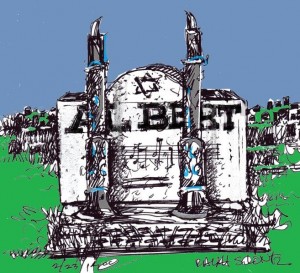 But I’d rather be in a cramped funky Jewish cemetery by the freeway, like Park’s cemetery. On the other hand, I do want to be near my wife’s bones, so I guess I’ll go with Lake View.
But I’d rather be in a cramped funky Jewish cemetery by the freeway, like Park’s cemetery. On the other hand, I do want to be near my wife’s bones, so I guess I’ll go with Lake View.
Maybe I can talk her into Park. How much time do I have?
—
You won’t want to read this part unless you’re very closely
related . . .
Bert’s parents, Theodore “Toby” and Julia (Zalk) Stratton are at Hillcrest Cemetery, 26200 Aurora Road, Bedford Heights. Temple Emanu El section, by the tree.
Toby’s parents, Louis and Anna (Seiger) Soltzberg, are at Chesed Shel Emeth Cemetery, aka Ridge Road #1, 3740 Ridge Rd. Cleveland. (“Front Left Section” — that’s what the cemetery sign says. The grave is about seven rows in from Ridge Road, before the Section 3 sign). Also, against the fence, Cecile Soltzberg, baby, Anna’s 3-year-old daughter, died about 1909.
Julia’s parents, Albert and Ida (Kassoff) Zalk, are at Workmen’s Circle Cemetery, 5100 Theota Ave., Parma. Their graves are not in the Workmen’s Circle Section. They are in the Warrensville Synagogue Section. Rear Left section. Section P, Row 11, grave 5. Here is a blog post about Bill Katz and me sneaking into that cemetery after-hours.
Ida’s parents, Morris and Sadie (Levine) Kassoff, are at Lansing Road Cemetery, 3933 E. 57th Street, Cleveland (Slavic Village). Anshe Grodno Section 1. Row 13. Graves 6 & 7.
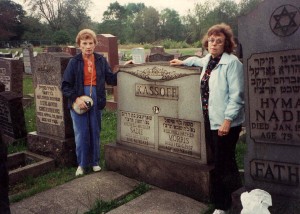 Julia (Zalk) Stratton (1920-2004), left, and her sister Celeste (Zalk) Kent (1926 – ) at their grandparents’ grave, 1997.
Julia (Zalk) Stratton (1920-2004), left, and her sister Celeste (Zalk) Kent (1926 – ) at their grandparents’ grave, 1997.
February 26, 2014 10 Comments
TEMPLE IN THE ROUND
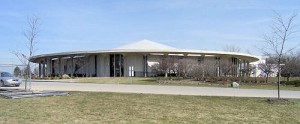
The former Brith Emeth temple in Pepper Pike, Ohio, looks like a clam shell or flying saucer.
My kids went to Hebrew school there. It was disorienting; I never knew which way to turn, right or left, to pick them up.
The acoustics in the social hall were bad. Everything was boomy.
Brith Emeth folded in 1986, and Park Synagogue East took over. Then Park Synagogue East sold the building to the Ratner School, a Montessori school. Now Kol HaLev — a Reconstructionist shul — rents from the Ratner School, the owner, for shabbes services.
When my band plays Kol HaLev, I tell my musicians, “We’re playing the clam shell.” I never say, “We’re playing Ratner Montessori School.” I also don’t say, “We’re playing the old Park East,” which would be confusing because there is a new Park East. I also don’t say, “27575 Shaker Boulevard,” because for a while, shrubs in front of the building obscured the address.
“We’re playing the clam shell, aka the flying saucer, guys.”
On October 17, 1969, Rabbi Philip Horowitz delivered the sermon “Is the Negro Equal?” at the clam shell.
The place still has a very sixties flare. I travel back in time every time I enter Brith Emeth. After-burners. The clam shell. The launch pad.
—
More on Brith Emeth here.
—
Yiddishe cup plays First Night Akron (Ohio), 6-8 p.m. Tues., Dec. 31.
—
SIDE B
For the record . . .
JUST NUMBERS
If you get a 3 percent return, on top of the inflation rate, that’s solid, middle of the road. But right now you can only get 1 percent on a CD, with inflation around 1 percent. You can’t get 3 percent without significant risk. If you go for more than 3 percent real growth, you’re taking a risk.
Risk in business is integral, part of the equation. Can’t be avoided.
You’re a genius; the stock market is booming. You weren’t a genius in 2008.
I know a woman who lost with Madoff, and now she’s doing the 1 percent CDs. I talked to another Madoff investor who said she had found a short-term investment that paid 20 percent. But for only 90 days. Twenty percent is 20 percent, doesn’t matter how long a period. Twenty percent is crazy. “That’s a lot of risk!” I said.
I have a friend who went in for CDOs (Collaterized Debt Obligation) and lost. He said he was getting 15 percent on them. But it only lasted a month. Then the whole thing collapsed.
We are here today to commemorate the fifth anniversary of the Madoff debacle . . . Another Madoff investor I know — enough with the Madoff! — this Cleveland schoolteacher said she didn’t think she was greedy when she was pulling in 10-12 percent a year from Madoff. She just thought she had made a good investment. I would have thought likewise. Madoff returned the schoolteacher’s original investment minus the paper gains. A small-timer, she got national TV attention for being a salt-of-the-earth Madoff victim.
The stock market typically clocks 9 percent per year, but that’s meaningless because the figure doesn’t take into account human behavior, known in the biz as “investors returns.” Most people buy and sell at the wrong time.
My father went all in on real estate 1965, and that’s why I’m in real estate now. He went in at the right time, luckily, and leveraged himself to the hilt. Our house was leveraged; he had second mortgages. He was gutsy, smart and fortunate. (He flopped at some other businesses.)
I’ve bought two buildings. The first building, I put down 25 percent and got a 10 ¾-percent mortgage. That was the going rate in 1987.
The second building, I put down 15 percent. I bought it from an old guy who was dying. I was dying too! The old guy lived another 21 years. The seller financed the deal; I didn’t have to go to the bank for a mortgage. I paid him off 17 years later. It worked out.
The first building — the one with the 10 ¾-percent mortgage — I paid off as quickly as possible. Took 7 1/2 years.
Win more than lose, hopefully.
And don’t chase 20 percent returns!
Hey, did my kids read this far?
December 25, 2013 8 Comments
THE HEYMISH AND THE AMISH
I live near two large Amish settlements — Middlefield, Ohio and Holmes County, Ohio. I know some of the differences between the various Amish sects. Some Amish use battery-powered lights on their buggies. Some don’t. Some use the triangular orange “slow vehicle” sign, some don’t.
 Speaking of guys-in-black, I also know some very frum Orthodox Jews. I know what the crocheted yarmulke means versus the black hat.
Speaking of guys-in-black, I also know some very frum Orthodox Jews. I know what the crocheted yarmulke means versus the black hat.
I’ve only been around Amish and Jews once. I saw an Amish man in the lobby of Green Road Synagogue — an Orthodox synagogue in Cleveland. I said to myself, “I’m wrong.”
This “Amish“ guy was probably a hipster Jew trying to look Amish, with a wide-brim hat, beard, no mustache and a vest. Like Solzhenitsyn.
I saw 15 Amish women in blue dresses and white bonnets come out of the kitchen. They carried parfaits on trays.
Then I saw a horse and buggy at the side door. (How does a horse and buggy get to suburban Beachwood? By truck.)
Solzhenitsyn stacked bales of hay in the temple lobby and brought in chickens. He was John, an Amish from Middlefield, and he worked for an Orthodox Jew who owned a mattress factory and was hosting a sheva brochas (post-wedding dinner). Yiddishe Cup played the dinner. We played our usual repertoire of Yiddish, Hebrew and klezmer. I asked the Amish buggy driver what he thought of the music. He said, “It sounds like Mozart.” Maybe because of the violin?
The man stacking the hay said some Amish in Ohio play harmonica — the 10-hole diatonic model. “That’s all, for instruments,” he said. “Other instruments [like flute, guitar] might lead to forming a band.” A Jewish joke?
The rabbi jokingly asked if Yiddishe Cup knew any Amish songs. We tried “Amazing Grace.” Probably a first for Green Road Synagogue. The Amish liked the song. We also played a Yiddish vocal, “Di Grine Kusine” (The Greenhorn Cousin), which the Amish didn’t seem to go for. I thought they would like our Yiddish repertoire, since the Amish speak Pennsylvania Dutch.
Now I know: go easy on the Yiddish at Amish-Jewish parties.

Alan Douglass, Yiddishe Cup’s keyboard player, Green Road Synagogue, 2011
—-
The Klezmer Guy trio plays Nighttown, Cleveland Hts., 7 p.m. Tues., April 23. $10. Play it safe and make a res: 216-795-0550.
An evening of social commentary, plumbing tips, and song. As if Garrison Keillor was raised on pastrami.
Alan Douglass, piano and vocals; Bert Stratton, clarinet and prose; Tamar Gray, vocals . . .
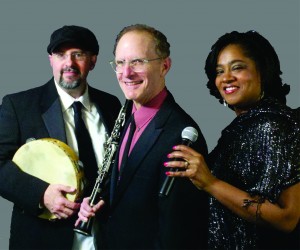
—
Next week “Klezmer Guy” posts up on Tuesday (April 23) instead of Wednesday. Just so I can remind you one more time about the April 23 Nighttown gig.
—
Mazel Tov to Sen. Jack Stratton (I-Calif.) for reaching his goal on Kickstarter. His band, Vulfpeck, hit the mark today.
Jack the Tummler . . .
April 17, 2013 1 Comment
SLY AND THE FAMILY STEIN
Beth El–the Heights Synagogue is the cool shul in Cleveland. Beth El recently held a jazz jam night.
Bud Sullivan blew tenor sax in the shul basement. I almost didn’t unpack my clarinet when I heard Bud’s quality licks. I eventually played along to “I Got Rhythm” and read a blog piece.
The rules for the next jazz night at Beth El: no prose or poetry.
I don’t think it was me. A poet read a five-minute screed about Nazi death camps. I — and probably others — hit the scotch schnapps hard after that guy. A comedian followed with Jewish jokes — straight from the Internet — for another five minutes. Deadly.
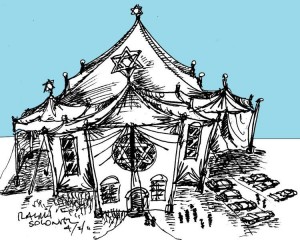 I’m a member of Park Synagogue, a block from Beth El. Park Synagogue is to Beth El as U. of Michigan is to Oberlin. Beth El is crunchy, cool; Park is the “big tent” champion — filled with thousands of hot, cold and in-between Jews. (I like both shuls.)
I’m a member of Park Synagogue, a block from Beth El. Park Synagogue is to Beth El as U. of Michigan is to Oberlin. Beth El is crunchy, cool; Park is the “big tent” champion — filled with thousands of hot, cold and in-between Jews. (I like both shuls.)
At Park Synagogue, I once brought in an Orthodox-style rapper for Purim. The rapper was half Orthodox/half reggae-man. The congregants nearly plotzed: a rap-a-holic in peyes and all- black.

Tamar Gray
This Purim Yiddishe Cup collaborates with a soul singer. Her name is Tamar. Perfect.
Bring your schnapps. You might need it.
Sly and the Family Stein at Park Synagogue.
—
Yiddishe Cup plays Purim at Park Synagogue, Cleveland Heights, Sat. (Feb 23). The service is 7:15-7:45 p.m.; the Jewish music is 7:45-8:45 p.m.; the Sly and the Family Stein portion begins around 9 p.m. Free. Open to the public. Wear a 1960s costume if you want.
—-
I wrote “Rust Belt Chic” for today’s CoolCleveland.com.
—-
This video has some chazones (cantoral music) in it.
Is this what a hipster looks like? . . .
February 20, 2013 3 Comments
AFRO-SEMITIC ENCOUNTER
I’m not Orthodox, but I can walk the walk. Walking is a major part of my religion.
Last week my wife, Alice, and I walked home from Rosh Hashanah services. We were at Altamont and Compton roads, in a mostly black section of Cleveland Heights — close to a mostly Orthodox neighborhood.
Three black boys pulled up on bikes. The boys were out of school because Cleveland Heights closes on Rosh Hashanah.
I had on a yarmulke. I like to wear a yarmulke in public once in a while, just to “out” myself.
D’Shawn, leaning on his handlebars, said, “You Jewish?”
“Yes,” I said.
He turned to Alice. “You Jewish?”
“Yes.”
“Total Jewish?” he asked.
“Yes,” my wife said, smiling. She knew D’Shawn. Alice teaches gym in the local public school and knows a lot of kids. “Being Jewish is a good thing. The food is good . . .”
“You go to that building [synagogue] up on Taylor?” D’Shawn asked.
“No, we go to the big temple — the one with the dome — over there,” Alice said, pointing toward Euclid Heights Boulevard.
Alice wears slacks. She doesn’t wear a wig. She doesn’t look Orthodox. (She isn’t — not by a long shot.)
“You breaking Armish?” D’Shawn said.
I said, “Breaking Armish? Did you say ‘breaking Armish’? What’s that mean? You mean ‘breaking Amish’?” Either way, it made no sense to me.
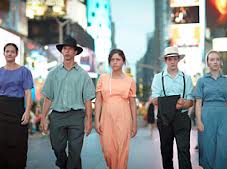
"Breaking Amish"
Breaking Amish is a reality TV show about Amish kids breaking loose in New York. The first episode was on last week. (I Googled this info when I got home.)
D’Shawn apparently thought Alice was “breaking Armish” because she doesn’t look like a member of the local black-hat Orthodox crowd.
—
Side B — “Beer and Coconut Bars,” a classic blog post — is below this video.
This clip may be the most innovative vid on earth. By Jack Stratton. Michael Brecker (on electronic wind instrument) jams with Uncle Milty Friedman.
—
SIDE B
A version of this post ran on CoolCleveland.com last year (12/6/11). This version has more illustrations and pics!
BEER AND COCONUT BARS
My dad admired bankers. In my dad’s pantheon of great Cleveland Jewish families, the number one clan was the Bilsky family, who made bagels, then went into medicine (son #1), bowling alleys (son #2), and started a bank (son #3). My grandmother used to say “The Bilskys make big bagels out of little bagels.”
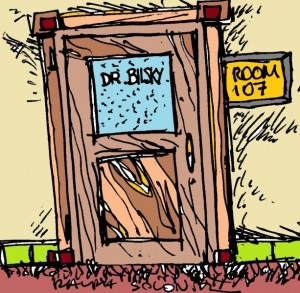 Scott Bilsky, 37, called to book Yiddishe Cup for a Fairmount Temple event. He said 12 Bilskys would be at the temple party.
Scott Bilsky, 37, called to book Yiddishe Cup for a Fairmount Temple event. He said 12 Bilskys would be at the temple party.
Dr. Harold Bilsky, son #1, had liked Yiddishe Cup. Harold had grown up with my dad on Kinsman Road. Harold wouldn’t be at the gig. He died in 2007. Leo, son #2, wouldn’t be there either. He died in 1998. I asked Scott, “What about the banker?”
“That’s my grandfather Marvin,” Scott said. “He’ll be there.” Marvin is 90.
At the gig, I talked to Marvin during our breaks. He told me, “Everything I ever did began with a B — baker, banker and builder. Plus brewer.”
That “brewer” part was news to me — Bilsky a brewski?
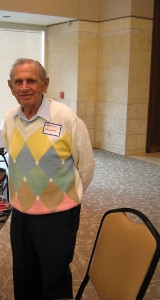
Marvin Bilsky, 2011
“My father bought Cleveland-Sandusky Brewing in 1955,” Marvin said. “There were very few Jews involved in the brewing business then. In the 1960s, Israel came to us for brewing tips and equipment.”
Marvin said there were only four other Cleveland breweries in the 1950s: Carling’s from Canada (“very nice people”); Standard Brewing; Erin Brew, Irish; Leisy’s, German; and Pilsener’s P.O.C., Czech. Bilsky’s brewery bottled Gold Bond beer and Olde Timers Ale.
“We all used to meet on Mondays. I didn’t have any trouble with anybody,” Marvin said.
The last local brewery in town was Carling, which closed in 1984. National breweries killed off the locals.
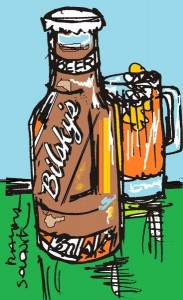 My father never taught me about brewskis. He rarely drank; it would have interfered with his worrying. (Old Jewish joke.) I knew about Carling’s from old Cleveland Indians’ radio ads. “Hey, Mabel, Black Label . . . Carling Black Label beer.”
My father never taught me about brewskis. He rarely drank; it would have interfered with his worrying. (Old Jewish joke.) I knew about Carling’s from old Cleveland Indians’ radio ads. “Hey, Mabel, Black Label . . . Carling Black Label beer.”
Bilsky’s brewery was just a blip in the Bilsky biz history. The Bilsky business was Bilsky’s Bakery, which had started on Kinsman and moved to Cedar Center in 1948.
Who invented the Cleveland coconut bar?
That was the question I should have asked Marvin. My dad had loved coconut bars (and halvah). I should have asked.
 Marvin was in the phone book . . . .
Marvin was in the phone book . . . .
“Marvin, this is Bert Stratton from Yiddishe Cup, the klezmer band.”
“Thank you for the concert yesterday. You did as well as you could,” he said. “No, seriously, we enjoyed it! To answer your question, I’ve always said my father invited the coconut bar, but — and I have to tell you this — I went to Sydney, Australia, and I went down into the subway there. They have a small subway system. They had coconut bars down there! They didn’t call them coconut bars. [Australians call them lamingtons, says Google.] Where did they get them? Maybe from England. Australia used to be part of England.”
“Marvin, I have a friend, my age — his grandfather was Kritzer’s Bakery on Kinsman — my friend says his grandfather invented the coconut bar.”
“It was my father!” Marvin said, laughing. “Who knows.”
I called my cousin George Becker, whose father had owned Heights Baking on Coventry. George said his father didn’t invented the coconut bar.
Yippee, one less Coconut Bar King to contend with.
Former Clevelander Scott Raab wrote in Esquire (July 2002): “Ask for coconut bars in any Jewish bakery from New Jersey to Los Angeles and you’ll get some version of this: ‘So, you’re from Cleveland . . . We don’t have ’em.’”
September 27, 2012 10 Comments
BREAD TOSS
On the afternoon of Rosh Hashanah, I’m on the Shaker Lakes bridge, hanging out with the Reconstructionist crowd. The Reconstructionist Jews are here for the Tashlikh ceremony. (Tashlikh is Hebrew for “casting off” — the symbolic casting-away-of-sins ceremony. Participants toss crumbs into a river or lake.)
I’m not a Reconstructionist, but I know a lot of the shul members.
I see others too. The guy who comes every day with his dachshunds, and the paraplegic guy, Brian. I run into a Swedish-American who is a convert. He says, “The Swedes taught the Jews about herring when the Swedes conquered Poland.” Good info.
The Recons leave, and a chavurah (small worship group) from a large Conservative synagogue comes through. A member tells me about a bar mitzvah in Minnesota that was too loud. Tell me about it.
The Recons at 3:30, the chavurah at 4:30.
I could go to Park Synagogue at 4:45 p.m., but that would be too much tash-likhing.
The Park Synagogue rabbi, at the morning service, had said, “It’s easy to do the right thing when you’re in shul, but the big test is the day after Rosh Hashanah — the days after the holidays. The routine days. The days when your wife shrinks your favorite sweatshirt, or you run a stop sign.”
Question, rabbi: Am I allowed to be bad on Rosh Hashanah — before I start to be good?
I get a phone message from a new tenant Rosh Hashanah afternoon. He has yet to move in. He needs to talk to me.
I tell my wife, “The guy doesn’t want to move in. I can smell it.”
I can’t resist calling him back. It’s late Rosh Hashanah. Around 6 p.m. I can do business at 6 p.m.
The guy is going to catch a break. I am not going to be vainly ambitious, grossly envious, insanely selfish, or indifferent to him.
“My mother is very sick,” he says. “I can’t move in.” He is 25. His mother is very sick like my mother is very sick; my mother is dead. The guy is lying. Not many 25 year olds have very sick mothers. I could ask him what exactly his mother has. I could ask him for a letter from the doctor. Instead, I say, “I’m sorry to hear about your mother,” and I tell him he won’t get his security back because he kept the apartment off the market for five weeks.
He says, “How about half back?”
I say no.
I have heard too many young people talk about their very sick mothers.
“My God, the soul you have given me is pure.” That’s in the Tashlikh prayer.
My soul is about 49-percent pure. That’s as good as it gets in the real estate biz. The kid found a cheaper place down the street, or moved in with his girl friend. That’s my guess.
—
Footnote: This was Rosh Hashanah, 2010.
—
SIDE B
ROSH HASHANAH PRAYER
There are risks that go along with being active.
Don’t be static. You’ll have plenty time for that when you’re gone.
The devil (yetzer hora) is always working. He don’t take no vacation.
Adapt.
Adapt to a colostomy, mastectomy, prostate surgery, the inability to walk, depression.
Don’t focus on what you’ve lost.
Focus on what’s good and what’s right in front of you: your children, your parents, the memories of your parents, your relatives, your friends, your community.
Life is not for the weak-hearted. Display some willpower! Do not take the short view. Seasons come and go. Get used to it.
This year we will not get wrapped up in things evil, harmful, or petty.
The health of our body is not just our singular “body,” but it’s our “bodies” — the people we work with, the people we love, the people we hang out with, the people we pray with.
Social isolation is not good. We’re all connected, particularly on days like Rosh Hashanah.
This is a day of aspiration and hope.
It’s our only hope.
Do not dwell on the bad. That is too easy.
Aspire to change. Focus.
Praise God.
September 12, 2012 3 Comments
FUNERAL REPPING
When my parents spent winters in Florida, I occasionally represented them at their friends’ funerals in Cleveland.
I didn’t like the work. My mother would call from Boca Raton and say, “Edith was such a good friends of ours. Please go, son.”
Screw Edith.
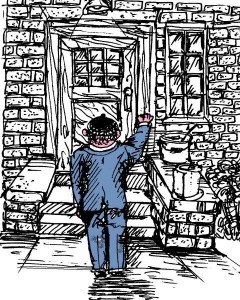 But I went. The hardest part was walking from my car to the shiva house. I pictured a bereaved relative opening the door and saying, “Who are you? Have you no decency? We don’t want any!”
But I went. The hardest part was walking from my car to the shiva house. I pictured a bereaved relative opening the door and saying, “Who are you? Have you no decency? We don’t want any!”
That never happened. I mingled with mourners. I was often the youngest non-relative there. Occasionally the rabbi would recognize me . . . “You have such a Stratton punim.” I looked like my mom or dad. Take your pick.
I eavesdropped. That was the action. An old woman said, “When I feel sick, I want to die. Then I get better and want to live.”
“Let me tell you something, deary,” another woman said. “They don’t ask when you want to die.”
My Cleveland Heights friends didn’t talk like that. They talked about marathons, 10Ks and Tommy’s milk shakes. A rabbi talked to me about the Cleveland Browns. Rabbis are into sports now, but a generation ago it wasn’t that common.
A food broker said, “I sell Heinen’s.”
Heinen’s didn’t interest me — not until at least fifteen years later.
I spent about twenty minutes per shiva call. The mourners were always appreciative.
My parents made me do it.
I’m glad.
—
Footnote:
While shiva repping, I met a California man who produced Joel Grey’s shows for 27 years. I said, “I’ll send you my band’s CD and you can show it to Joel. No, on second thought, I won’t send it, because Joel might sue me for ripping off Mickey Katz tunes.”
“Don’t worry,” the producer said. “Lebedeff’s people tried to hit Joel up for royalties on ‘Romania, Romania’ for years. No luck.”
—
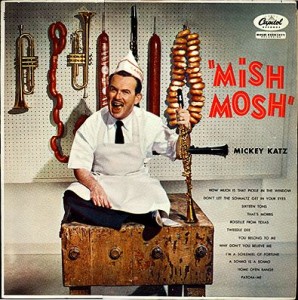 Yiddishe Cup plays 7 p.m. tomorrow (Thurs. Aug. 9) at Cain Park, Alma Theater, Cleveland Hts. We’re doing a tribute to Mickey Katz.
Yiddishe Cup plays 7 p.m. tomorrow (Thurs. Aug. 9) at Cain Park, Alma Theater, Cleveland Hts. We’re doing a tribute to Mickey Katz.
A documentary filmmaker from D.C. plans to be there. You might wind up in the movie.
Tickets are $20-22 in advance and $23-25 manana. Discounts for seniors and students. www.cainpark.com and 216-371-3000.
August 8, 2012 1 Comment
PUNCHES WERE THROWN
Rabbi Samuel Benjamin — from my synagogue — was arrested by the cops and beat up by congregants. Then he got fired. He went off to Jerusalem.
He resurfaced stateside in Jacksonville, Florida.
This was in 1926. Rabbi Benjamin fought the great Conservative-Orthodox civil war at the Cleveland Jewish Center, East 105th Street, in the early 1920s.
Rabbi Benjamin oversaw the construction of a huge new sanctuary, complete with a swimming pool, and was supposed to keep the shul Orthodox. He tried. But the Conservatives wanted him out. Punches were thrown. One of the punchers was a certain Philip Rocker. Check it out.* The rabbi left town.
The Cleveland Jewish Center, aka the “Polish synagogue,” aka Anshe Emeth Beth Tefilo, stayed at East 105th Street for a couple decades, then moved to a park-like setting in Cleveland Heights.
I belong to the Heights shul — Park Synagogue. I do not see any signs of civil war. Very few congregants know about Rabbi Benjamin.
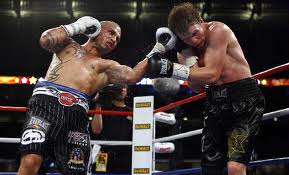 Rabbis don’t get in fights like they used to, either. Does any rabbi don boxing trunks with the Jewish star? I think there is a Russian rabbi in New York who does. [Yes, Yuri Foreman. Photo: Foreman taking a punch from Miguel Cotto.]
Rabbis don’t get in fights like they used to, either. Does any rabbi don boxing trunks with the Jewish star? I think there is a Russian rabbi in New York who does. [Yes, Yuri Foreman. Photo: Foreman taking a punch from Miguel Cotto.]
My rabbi doesn’t fight — my guess. If he does, he’s a welterweight. He’s not big.
Some rabbis play basketball. Several Cleveland rabbis played an exhibition basketball game at the Cleveland Cavaliers pre-game this month. There was no score in ten minutes.
Next year for the pre-game, the rabbis should reenact the Conservative-Orthodox civil war of 1921.
—
* “Near [Rabbi Benjamin’s] house was Philip Rocker, son of Samuel Rocker of The Jewish World. He waited for the rabbi and when he saw him he attacked him and beat him up quite severely.” From Jewish Life in Cleveland in the 1920s and 1930s by Leon Wiesenfeld, 1965.
—
SIDE B
Jumping ahead about 90 years . . .
THE JEWISH WEDDING BAND WARS, 2009
The Orthodox Jewish (OJ) music scene is centered in New York City, where most of the OJ gigs are.
An OJ band not based in New York is called an “out of town” band, even if the band plays its own hometown. There are a couple home-grown “out of town” OJ bands in Cleveland.
The Barry Cik Orchestra dominated the Orthodox Jewish Cleveland music scene in the 1980s. Cik had yikhes (lineage), coming from a long line of distinguished Hungarian musicians. I played a couple gigs with him. His talented son Yehuda became an Ortho pop star.
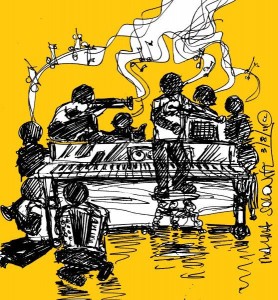 Barry Cik was superseded in Cleveland by the Kol Simcha Orchestra in the 1990s. Some bridal couples perceived Cik as not being frum (religiously observant) enough. The Orthodox world, in general, was becoming increasingly more ritually observant.
Barry Cik was superseded in Cleveland by the Kol Simcha Orchestra in the 1990s. Some bridal couples perceived Cik as not being frum (religiously observant) enough. The Orthodox world, in general, was becoming increasingly more ritually observant.
Cik placed an ad in the Cleveland Jewish Times (no longer in existence) in 1991 that read in part: “I am as scrupulous in shimras Shabbos [guarding the Sabbath] as I can be, and I don’t believe that I’m any less Shomer Shabbos [Sabbath-observant] than most anybody else.”
Cik sometimes played for non-Orthodox Jewish simchas (celebrations) with mixed dancing — men and women dancing together. Kol Simcha — the new band– typically didn’t play for mixed dancing. Kol Simcha picked up a chunk of Cik’s frummer gigs.
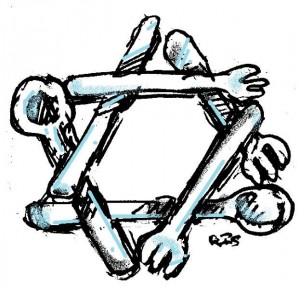 Kol Simcha’s drummer got in trouble for using treyf (non-kosher) meat at his kosher Chinese restaurant, so he left town. Still, Kol Simcha — the band — stayed in business. The lead singer, Rabbi Simcha Mann, was a very good singer.
Kol Simcha’s drummer got in trouble for using treyf (non-kosher) meat at his kosher Chinese restaurant, so he left town. Still, Kol Simcha — the band — stayed in business. The lead singer, Rabbi Simcha Mann, was a very good singer.
Several years later Simcha Mann’s expert keyboard player, Yosef Greenberger, put together a one-man band, which cut into Kol Simcha’s full-band wedding business.
Simcha Mann and Yosef Greenberger took their dispute to an unofficial beis din (house of judgment), where three rabbis decided Greenberger could keep his one-band and Rabbi Mann could have the full-band scene. The two musicians agreed not to cut into each other’s turf.
This ruling held for 13 years, 1996 to 2009.
In 2009 Greenberger and Mann remembered the ruling differently. Greenberger recalled the rabbis saying the ruling was void if new competition came to town. Greenberger’s Jewish-law counsel, his toyan, backed him up in writing. Mann disagreed.
New bands were playing Cleveland. Yosef expanded to a full band. Orthodox bands from Columbus, Ohio, and Detroit came through. A young Orthodox musician started a new Cleveland Ortho band.
Yiddishe Cup joined the fray! But Yiddishe Cup had three major flaws:
1. Yikhes (lineage/pedigree). We had none.
2. We didn’t know the OJ repertoire very well.
3. Yiddishe Cup’s name was unorthodox.
For Ortho purposes, Yiddishe Cup became Shir Perfection. (Shir is Hebrew for song.) We had an Ortho singer who knew all the Ortho tunes. We held a couple rehearsals. These get-togethers were secretly called Project O. (‘O” for Orthodox.) One musician called our project “Project Zero”; he didn’t like OrthoRock music and dropped out.
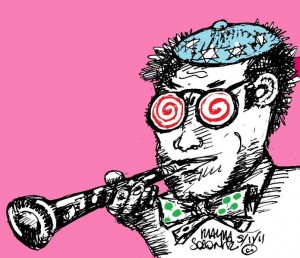 We didn’t get any gigs. We thought we might get a couple. For instance, Yiddishe Cup once played an OJ wedding for the daughter of an Orthodox blues harmonica player. The dad, who didn’t blow on shabbes, sat in with us.
We didn’t get any gigs. We thought we might get a couple. For instance, Yiddishe Cup once played an OJ wedding for the daughter of an Orthodox blues harmonica player. The dad, who didn’t blow on shabbes, sat in with us.
We were looking for Ortho gigs like that.
Still looking.
March 28, 2012 11 Comments
THE OPTIMAL LEVEL OF JEWISHNESS
If I didn’t lead a klezmer band, I might not hire one. Yiddishe Cup might be too Jewish for me.
“Too Jewish” means anything — or anybody — more Jewish than oneself. Example: Franz Rosenzweig, a German Jewish intellectual, said nothing Jewish — no matter how far out — was alien to him. I tried Franz’s approach: I davened (prayed) with the yeshiva buchers in Boro Park, Brooklyn; drank schnapps at Telshe Yeshiva, Cleveland; and soaked in the mikvah (ritual bath) in Cleveland Heights. Also, I read Rabbi Sherman Wine’s God-is-dead books. I covered a lot of humentashn (bases).
Would I hire a klezmer band?
Yes.
I did. I hired Yiddishe Cup three times — for my kids’ b’nai mitzvot parties. (And I got a decent price.)
1. For my daughter’s bat mitzvah party, I also hired a troupe of hospital-therapy dogs for the cocktail hour.
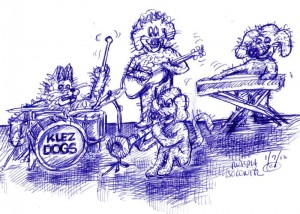
2. For my younger son, we had a DJ party, plus the klez band party. My son organized the DJ party. He hired the DJ — himself.
3. My older son had a trivia quiz, plus the klezmer band. That worked out well. He wound up on Jeopardy!
Yiddishe Cup plays, at minimum, 15 minutes of Jewish music, and we use a dance leader, so everybody knows what to do.
Naturally, the goys like us best. Jews have hang-ups.
I know about Jews and hang-ups. I have belonged to more shuls than the Pope. I was Reform, then Conservative, then Reform, and now Conservative again.
My friends and relatives don’t always hire Yiddishe Cup. But I go to their parties and have a good time. The weddings are enjoyable; the bar mitzvahs are sometimes difficult. The DJ and his “dance facilitators” can be loud and obnoxious. The DJ announces, “The young adults will gather on the dance floor for a group photo.”
Get in the picture yourself, DJ. You look 18. And the “young adults” are not young adults, they’re animals. Stow the glow sticks. Bring out the cattle prods.
The optimal level of Jewishness is Yiddishe Cup with therapy dogs.
—
Yiddishe Cup plays The Ark 8 p.m. Sat (Feb.4), Ann Arbor, Mich. Here is an unrepresentative video from last year’s show:
February 1, 2012 11 Comments
OLD SHUL
Zemach Zedek, on Lee Road by the old Cleveland Heights post office, is the only storefront shul left in Cleveland.
I was in Zemach Zedek (Z.Z.) a few months ago with my cousin’s teenage son Aaron, who was visiting from Kansas City. Aaron is Orthodox and wanted to go to morning minyan (quorum).
Because I’m a lefty, I needed left-handed tefillin (tefillin). The nine other guys in the minyan had to scramble for lefty tefillin. (Lefty tefillin are wrapped different than righty. Fact: Lefty tefillin go on the right arm.)
Afterward, I asked Aaron if he wanted to go back the next day to daven (pray). He said, “I don’t think anybody there speaks English. It was like Europe or something.” So we went to Green Road, to a Modern Orthodox shul.
I knew the rabbi at Z.Z. Rabbi Kazen. He wasn’t there. He was living with family in New York, I heard.
Chabad-Lubavitch –- headquartered in New York –- had sent Rabbi Kazen out to Cleveland in 1953. Rabbi Kazen was a shochet (ritual slaughterer) at Coventry Poultry while running the shul. Coventry was the last live kosher poultry market in Cleveland. (Rabbi Kazen was involved in a few “lasts.”) Coventry Poultry closed in 1995 to make way for a parking garage. My wife, Alice, did a photo project on Rabbi Kazen in 1980:
I admired Rabbi Kazen. He drove a school bus — often filled with Russian immigrants — and lived on Glenmont Road in the student area. He appeared to be the emes: the real thing. He fed the poor and was usually in a good mood. Rabbi Kazen looked like Menachem Schneerson, the late head rabbi of Chabad. (No biggie. Half of Chabad looks like Rabbi Schneerson.)
I first heard the word freylekh at Rabbi Kazen’s in 1978. A davener (worshipper) said to Rabbi Kazen, “Your daughter’s khasene, rabbi, it should be freylekh.”
What? I didn’t understand the Yiddish “punch line.”
I guessed the first part correctly (chasene) from the context. Wedding. [Years later, an Orthodox woman said to me, “Does Yiddishe Cup play chasenes?” I said, “Yes, we’ve played for Hadassah.” She said, “Chasenes!”]
I asked the davener at Rabbi Kazen’s what freylekh meant.
Freylekh is “cheerful, lively.”
Freylekhs is also a klezmer term for a lively fast dance. I say “freylekhs” a lot now. I announce: “The band is going to play a freylekhs, hora, ‘Hava Nagilah’ medley . . . whatever.” And we hit the downbeat.
Rabbi Kazen died last week at 92 in New York.
Strike up a freylekhs — and a “Chicken Dance” lick — for Rabbi Kazen and Z.Z.
July 20, 2011 11 Comments
NOT A PASSOVER STORY
Bialy’s Bagels in University Heights, Ohio, was my bagel supplier for years. I would go swimming; go to Bialy’s; buy 15 bagels; eat two; drive to my mother’s, give her three; and take the rest home.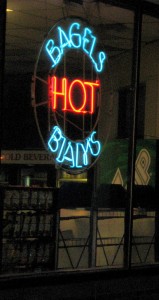
I was on a bagel diet; I actually thought eating sesame and poppy seed bagels was a good thing.
My back-up bagel purveyor was Amster’s at Cedar Center. The counter woman there, Marilyn Weiss, volunteered for school levies, racial integration projects, and did a ton of schlep work at my shul. Amster’s was all about Marilyn’s personality. Unfortunately, she died in 2000, and the place closed a few years later.
I also went to Better — as in “Better Bagel” — on Taylor Road. The owners were New Yorkers who wore kippot (yarmulkes) and Brooklyn Dodgers shirts. I figured they knew bagels.
They didn’t. Their bagels were too doughy and not crispy enough on the outside. Better Bagel changed its name to Brooklyn Bagel. No better.
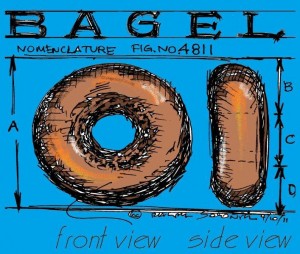
Go to Bialy’s. If Bialy’s ever closes, we’re in bagel trouble in Cleveland.
April 20, 2011 15 Comments
B’NAI BIG TENT

Yiddishe Cup does the occasional Torah march. We escort Torah scrolls and marchers in a parade from a “desanctified” synagogue to a newer synagogue.
We’re doing a Torah march Sunday, going from tiny Congregation Bethanyu in Pepper Pike, Ohio, to B’nai Jeshurun Congregation (BJ), a half mile away.
BJ is a shul-eater. It eats guppy shuls.
BJ is one of two “big tent” Conservative synagogues in Cleveland. The other is Park Synagogue. Park is bigger, but BJ is working on its mergers and acquisitions.
Two of BJ’s “guppy” meals were temples that had split off from BJ and — after decades of independence — re-docked with the mother ship (BJ).
Jewish unity: Jewnity. Jewnity means all Jews under one roof.
Rabbi Milton Rube, the emeritus rabbi at Bethanyu — the tiny shul that is closing — had been an assistant rabbi at BJ in the 1970s, when he and a group of young congregants split off. That’s how it goes; the young rabbi and young congregants think the stodgy old rich members are running the show too much.
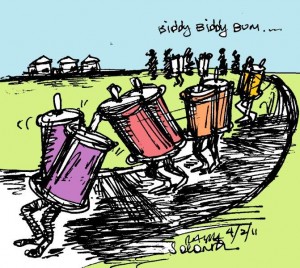
March of the Torahs, Pepper Pike
Last month, in the Cleveland Jewish News, Rabbi Rube said he personally won’t re-dock with BJ. He’s joining Park — the competition.
This is newsworthy, but not everybody thinks so. I tried to discuss Rabbi Rube at shabbes dinner (because temple gossip is a shabbes tradition at my house), but my friends at the shabbes table didn’t know what I was talking about. Did they even read the Cleveland Jewish News? No. Did they think the Jewish News was only for their parents? Yes. And their parents are mostly dead.
What if some day there is only one “big tent” Conservative shul left in Cleveland? Which will it be, Park or BJ? Who’s interested in that discussion?
If you are, please bring a challah (preferably from On the Rise bakery), a side dish and terrific chocolate dessert to my house this Friday night.
—-
THIS BLOG IS UPDATED every Wednesday morning. No more Friday morning updates. (Nobody was checking in then anyhow.)
Please stop by here every Wednesday morning for the latest. That’s probably what you’re already doing.
The Wednesday-morning tan email reminders will continue to go out, as usual.
April 6, 2011 11 Comments
YID LIDS
Maybe a collage artist can do something with my yarmulke collection, from 22 years’ worth of gigs. I know an artist — a bad one — who did something with old saxophone reeds.
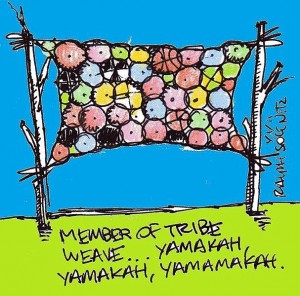 My Guatemalan yarmulkes, crocheted by Mayan Indians, are from neo-hippie weddings. There are no bouquet tosses, garter-belt strip routines, or formal introductions at these weddings. The Mayan kippot (yarmulkes) are particularly popular with female rabbi brides. That’s a niche — weddings of women rabbis — that Yiddishe Cup has cornered in the Midwest.
My Guatemalan yarmulkes, crocheted by Mayan Indians, are from neo-hippie weddings. There are no bouquet tosses, garter-belt strip routines, or formal introductions at these weddings. The Mayan kippot (yarmulkes) are particularly popular with female rabbi brides. That’s a niche — weddings of women rabbis — that Yiddishe Cup has cornered in the Midwest.
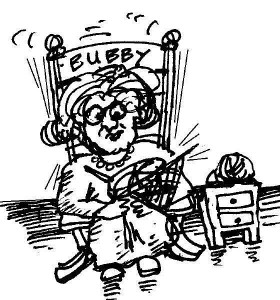 The most heymish lids are grandmas’ knitted yarmulkes.
The most heymish lids are grandmas’ knitted yarmulkes.
My blue suede yarmulkes are from A-1 Skull Caps. The lids don’t breathe. Skull cap. I like a yarmulke that breathes.
Camouflage kippahs exist, too. One Yiddishe Cup musician, a pacifist, declined to wear his camo lid at a Zahal-themed bar mitzvah. Zahal is the Israel Defense Forces (IDF). The bar mitzvah boy’s father wore combat boots and a full Israeli uniform. The band wore IDF T-shirts and camouflage yarmulkes. (Nobody noticed our musician in street clothes.)
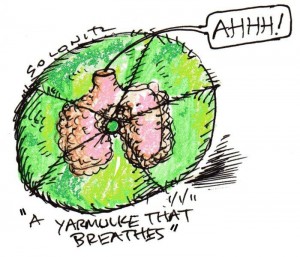 I have six purple kippot from a bar mitzvah. I thought the band might want to wear the lids again at another bar mitzvah. Go for the clean David Clark Five look. The guys declined.
I have six purple kippot from a bar mitzvah. I thought the band might want to wear the lids again at another bar mitzvah. Go for the clean David Clark Five look. The guys declined.
We wore sports yarmulkes — plus basketball jerseys — at a sports-themed bar mitzvah party. The party even had a cheerleading squad:
Mazel tov / Let’s shout hurray / It’s Jeremy and Sam’s bar mitzvah day!
I say oy / You say vey / Jeremy and Sam are men today!
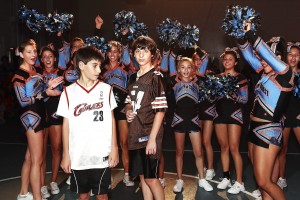
Yiddishe Cup’s keyboard player, Alan Douglass, frequently asks, “Is this a yarmulke gig?” He’s a goy and can’t figure out what’s up with the various Jewish denominations.
My Conservative rabbi wears a throwaway satin lid that funeral homes and synagogues give out. He apparently doesn’t want to look different from his congregants. I haven’t asked yet — after 20 years — why he wears the throwaway.
My white satin yarmulke from Dec. 9, 2007 has “Ananth Uggirala” — the groom’s name — in it. The groom’s parents were Anjaneyulu and Manorama Uggirala. I had to announce them. Tip, please.
You need good hair clips for a yarmulke. Bobby pins are the worst; they take your hair out with the yarmulke. Duck bill clips – also no good. The best clips are the surfboard barrettes. If you don’t have these clips, get some, particularly for outdoor gigs.
If you drop a yarmulke, you don’t have to kiss it before putting it back on. A lid is a lid. It’s not a holy object. Also, goys, wear the lid at the wedding ceremony; you’re not exempt.
At an American-Israeli wedding, one of the chuppah (bridal canopy) bearers smoked and balanced a drink. His yarmulke fell off. Secular Israelis, they’re funny that way.
It’s shocking when you see an Orthodox guy without a lid. For instance, an Orthodox man might go into a non-kosher restaurant on a road trip and take his yarmulke off. (Some Orthodox, when in the sticks, will go to a fast-food place for a salad.)
I wore a yarmulke for a week when I hitchhiked the coast of California in my twenties. I had seen a photo of Bob Dylan wearing a yarmulke at the Western Wall. Dylan did yahm-ops at The Wall every couple decades, it seemed.
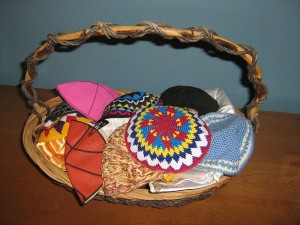
My Easter basket of yahms makes for a moderately interesting pop-psych experiment on shabbes: Who is going to take the pink, who is going to take the matzo-textured lid, and who is going to hide behind the black lid?
Have fun with lids. That’s in the Torah somewhere.
January 5, 2011 9 Comments
